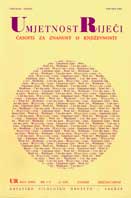W. B. Yeats i Dekatendizam
W. B. Yeats and Decadentism
Author(s): Ljiljana Ina GjurgjanSubject(s): Literary Texts
Published by: Hrvatsko filološko društvo
Keywords: Yeats W.B.;
Summary/Abstract: This article starts with the contention that decadence is defined by hyper-aestheticism, stylised artistic expression, tendency towards extravagant, deviant behavior and a neo-Platonic attitude towards reality. Yeats’s poem Sailing to Byzantium and his turn-of-the-century articles The Symbolism of Poetry and The Autumn of the Body are decadent insofar that they claim the prevalence of conceptual over natural representation and see the poet as the priest of the new age. However, to understand the difference between Yeats’s poetics and the poetics of decadence, we have to understand the symbolic meaning he ascribes to Byzantium. In A Vision he claims that »in early Byzantium [...] religious, aesthetic and practical life were one«. Thus, Byzantium becomes the symbol of the state of mind in which »the body is not bruised to pleasure soul« (Among School Children). Contrary to the duality between body and soul, which is characteristic of modern Western culture, Yeats’s poetry is informed by a desire for ultimate synthesis. Consequently, neo-Platonic prevalence of art over life, which is characteristic of decadence, is replaced by the notion of the Unity of Being. In The Statues, outlining his vision of history, Yeats claims that not only personal, but even national recuperation as well as spiritual decolonialization can be reached only through art.
Journal: Umjetnost riječi
- Issue Year: 2002
- Issue No: 1-2
- Page Range: 87-97
- Page Count: 11
- Language: Croatian

